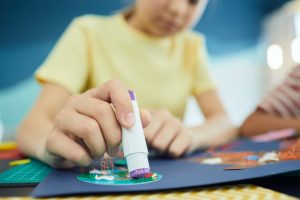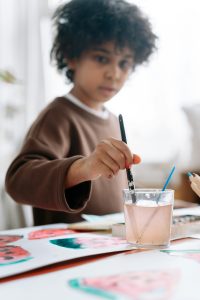
In my practice, generally, children and young people come to the session and bring what’s happening with them in the present. Maybe they just want to talk and unravel something, maybe they don’t want to talk or they can’t find the words, but they’re open to engaging with something creative, like giving shape and colour to whatever’s going on. And out of these expressions, the symbols and metaphors can also act as prompts which can lead to exploring key words based on the images. The space is sacred. Moreover, the relatedness and attuned responses of the therapist and everything that occurs in the space acts as a safe container which generates a sense of ease.
Children need and crave attentiveness, loving care and kindness, validation and attuned responses from the adults around them.
Active imagination
Carl Jung’s depth psychology acknowledges the soul which carries an imago (Latin root word for imagination) and integrates active imagination whether verbally or through the creative arts.
Active imagination can be seen as a bridge which is able to access the unknown parts of the self. Through creative imagery it conveys its message on multiple and subtle levels. By these means, the abstract, non-linear images in art and dreams translate into something tangible and coherent, creating a cohesive narrative.
Connection
In the therapeutic use of the arts an intention arises out of what the child or adolescent client brings to the session. There is connection between the person creating the imagery and the image itself. Creativity is potent and stirs up life-force energy and new ways of thinking and being. It helps to mobilise inertia in the kinetic act of moving into a creative space and using the body, such as the hands to work with clay, paint, draw, do a collage or simply create structures using pipe-cleaners.
Left-right brain hemispheres
When I’m with a child-young person who’s vocabulary and left-brain rational and reasoning skills are very well developed, this does not mean that they are further on in their emotional age-related development. Often, what I see is an emerging false self in order to be approved of, and feelings get buried to adapt to what is expected of them. We cannot bypass feelings in therapy but that doesn’t mean re-traumatisation if such is the case – this is where expressive arts can be worked through in the metaphors.
So we could say, that when the left side of the brain where logic lives, harmonises with the right hemisphere in the fertile soil where intuition grows and feelings are felt, this fusion brings all the elements together. Imagination is closely connected to intuition and when applied in therapy is conducive to regenerating vitality in a transformative way.
Creativity is a wild terrain. Through the intuitive imagination where wisdom resides, the child-young person can contemplate and consider, what does it say? This integrative therapeutic use of the arts allows the intuition to bypass limited thoughts and unhelpful beliefs. This is a visceral experience. It’s about letting go of control, letting go of a fixed idea such as “I can’t do this,” to simply doing it and allowing each step to inspire the next.
Self-awareness is a key
When the child, adolescent or young adult receives fresh realisations, they tap into their sense of higher self, discovering a way in, to the inner resources by the gentle facilitations offered in the therapy space.
As a creative therapist I serve the purpose as a vessel to allow the individual to tap into their systemic antennae. I guide them intuitively to open the interior doorways, exploring what they can handle at any given moment.
It’s beautiful work when the young person is receptive and willing to remove their armour while they journey into their inner landscapes and bring back gifts that no-one can take away.
Creative expression is needed, like the sun and rain nourishes a flower.

